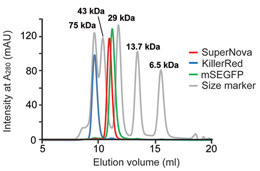単量体型光増感性蛍光タンパク質SuperNovaによる発色団補助光不活性化法
SuperNova, a monomeric photosensitizing fluorescent protein for chromophore-assisted light inactivation
2013年9月17日 Scientific Reports 3 : 2629 doi: 10.1038/srep02629

発色団補助光不活性化法(Chromophore-assisted light inactivation;CALI)は、生体試料内において、活性酸素種(ROS)により生体分子を急速かつ任意の時空間で不活性化する強力な技術である。フルオロセインをはじめとする小分子光増感剤は、外部から標本に侵襲的に導入しなければならず、特定の細胞や細胞内小器官に限局させることができないが、KillerRedという遺伝子にコードされた光増感剤は、組織特異的プロモーターや細胞内局在タグを用いることで、その発現を制御することが原理的には可能である。この優位性はあるものの、KillerRedには二量体化する性質があり、目的とするタンパク質との融合の妨げになるため、いまだ汎用的なツールにはなっていない。本研究では、KillerRedをランダム突然変異誘発により進化させることで得られた単量体型改変体(SuperNova)について報告する。KillerRedとは異なり、SuperNovaは標的タンパク質と融合させても、適切な局在を示す。さらに、KillerRedと違う点は、SuperNovaの発現は細胞の有糸分裂を妨げない。SuperNovaはROSの産生能力を保持しているため、KillerRedの主要な欠点が克服され、CALIによる標的タンパク質の機能解析が進展するであろう。
竹本 研1*, 松田 知己1**, 坂井 直樹2***, Fu Donald3, 野田 勝紀4, 内山 進4, 小寺 一平3, 新井 由之1**, 堀内 正隆5, 福井 希一4, 綾部 時芳2, 稲垣 冬彦5, 鈴木 啓史3 & 永井 健治1**
- 北海道大学 電子科学研究所
- 北海道大学 大学院先端生命科学研究院
- Tanz Centre for Research in Neurodegenerative Diseases, and Dept of Physiology, University of Toronto (カナダ)
- 大阪大学大学院 工学研究科
- 北海道大学大学院 薬学研究
*現所属先:横浜市立大学大学院 医学研究科
**現所属先:大阪大学 産業科学研究所
***現所属先:Institute of Biochemistry, Center for Structural and Cell Biology in Medicine, University of Lübeck (ドイツ)

